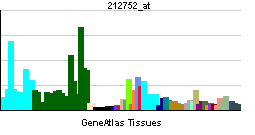CLASP1
| Cytoplasmic linker associated protein 1 | |||||||||||
|---|---|---|---|---|---|---|---|---|---|---|---|
| Identifiers | |||||||||||
| Symbols | CLASP1 ; MAST1; DKFZp686D1968; DKFZp686H2039; FLJ33821; FLJ41222; KIAA0622; MGC131895 | ||||||||||
| External IDs | Template:OMIM5 Template:MGI HomoloGene: 41024 | ||||||||||
| |||||||||||
| RNA expression pattern | |||||||||||
 | |||||||||||
 | |||||||||||
 | |||||||||||
| More reference expression data | |||||||||||
| Orthologs | |||||||||||
| Template:GNF Ortholog box | |||||||||||
| Species | Human | Mouse | |||||||||
| Entrez | n/a | n/a | |||||||||
| Ensembl | n/a | n/a | |||||||||
| UniProt | n/a | n/a | |||||||||
| RefSeq (mRNA) | n/a | n/a | |||||||||
| RefSeq (protein) | n/a | n/a | |||||||||
| Location (UCSC) | n/a | n/a | |||||||||
| PubMed search | n/a | n/a | |||||||||
Cytoplasmic linker associated protein 1, also known as CLASP1, is a human gene.[1]
CLASPs, such as CLASP1, are nonmotor microtubule-associated proteins that interact with CLIPs (e.g., CLIP170; MIM 179838). CLASP1 is involved in the regulation of microtubule dynamics at the kinetochore and throughout the spindle (Maiato et al., 2003).[supplied by OMIM][1]
References
Further reading
- Galjart N (2005). "CLIPs and CLASPs and cellular dynamics". Nat. Rev. Mol. Cell Biol. 6 (6): 487–98. doi:10.1038/nrm1664. PMID 15928712.
- Ishikawa K, Nagase T, Suyama M; et al. (1998). "Prediction of the coding sequences of unidentified human genes. X. The complete sequences of 100 new cDNA clones from brain which can code for large proteins in vitro". DNA Res. 5 (3): 169–76. PMID 9734811.
- Lemos CL, Sampaio P, Maiato H; et al. (2000). "Mast, a conserved microtubule-associated protein required for bipolar mitotic spindle organization". EMBO J. 19 (14): 3668–82. doi:10.1093/emboj/19.14.3668. PMID 10899121.
- Akhmanova A, Hoogenraad CC, Drabek K; et al. (2001). "Clasps are CLIP-115 and -170 associating proteins involved in the regional regulation of microtubule dynamics in motile fibroblasts". Cell. 104 (6): 923–35. PMID 11290329.
- Strausberg RL, Feingold EA, Grouse LH; et al. (2003). "Generation and initial analysis of more than 15,000 full-length human and mouse cDNA sequences". Proc. Natl. Acad. Sci. U.S.A. 99 (26): 16899–903. doi:10.1073/pnas.242603899. PMID 12477932.
- Maiato H, Fairley EA, Rieder CL; et al. (2003). "Human CLASP1 is an outer kinetochore component that regulates spindle microtubule dynamics". Cell. 113 (7): 891–904. PMID 12837247.
- Maiato H, Rieder CL, Earnshaw WC, Sunkel CE (2004). "How do kinetochores CLASP dynamic microtubules?". Cell Cycle. 2 (6): 511–4. PMID 14504462.
- Ota T, Suzuki Y, Nishikawa T; et al. (2004). "Complete sequencing and characterization of 21,243 full-length human cDNAs". Nat. Genet. 36 (1): 40–5. doi:10.1038/ng1285. PMID 14702039.
- Beausoleil SA, Jedrychowski M, Schwartz D; et al. (2004). "Large-scale characterization of HeLa cell nuclear phosphoproteins". Proc. Natl. Acad. Sci. U.S.A. 101 (33): 12130–5. doi:10.1073/pnas.0404720101. PMID 15302935.
- Jin J, Smith FD, Stark C; et al. (2004). "Proteomic, functional, and domain-based analysis of in vivo 14-3-3 binding proteins involved in cytoskeletal regulation and cellular organization". Curr. Biol. 14 (16): 1436–50. doi:10.1016/j.cub.2004.07.051. PMID 15324660.
- Gerhard DS, Wagner L, Feingold EA; et al. (2004). "The status, quality, and expansion of the NIH full-length cDNA project: the Mammalian Gene Collection (MGC)". Genome Res. 14 (10B): 2121–7. doi:10.1101/gr.2596504. PMID 15489334.
- Mimori-Kiyosue Y, Grigoriev I, Lansbergen G; et al. (2005). "CLASP1 and CLASP2 bind to EB1 and regulate microtubule plus-end dynamics at the cell cortex". J. Cell Biol. 168 (1): 141–53. doi:10.1083/jcb.200405094. PMID 15631994.
- Hillier LW, Graves TA, Fulton RS; et al. (2005). "Generation and annotation of the DNA sequences of human chromosomes 2 and 4". Nature. 434 (7034): 724–31. doi:10.1038/nature03466. PMID 15815621.
- Venables JP, Bourgeois CF, Dalgliesh C; et al. (2005). "Up-regulation of the ubiquitous alternative splicing factor Tra2beta causes inclusion of a germ cell-specific exon". Hum. Mol. Genet. 14 (16): 2289–303. doi:10.1093/hmg/ddi233. PMID 16000324.
- Aonuma M, Miyamoto M, Inoue YH; et al. (2006). "Microtubule bundle formation and cell death induced by the human CLASP/Orbit N-terminal fragment". Cell Struct. Funct. 30 (1): 7–13. PMID 16145243.
- Lansbergen G, Grigoriev I, Mimori-Kiyosue Y; et al. (2006). "CLASPs attach microtubule plus ends to the cell cortex through a complex with LL5beta". Dev. Cell. 11 (1): 21–32. doi:10.1016/j.devcel.2006.05.012. PMID 16824950.
- Mimori-Kiyosue Y, Grigoriev I, Sasaki H; et al. (2006). "Mammalian CLASPs are required for mitotic spindle organization and kinetochore alignment". Genes Cells. 11 (8): 845–57. doi:10.1111/j.1365-2443.2006.00990.x. PMID 16866869.
- Pereira AL, Pereira AJ, Maia AR; et al. (2007). "Mammalian CLASP1 and CLASP2 cooperate to ensure mitotic fidelity by regulating spindle and kinetochore function". Mol. Biol. Cell. 17 (10): 4526–42. doi:10.1091/mbc.E06-07-0579. PMID 16914514.
- Ewing RM, Chu P, Elisma F; et al. (2007). "Large-scale mapping of human protein-protein interactions by mass spectrometry". Mol. Syst. Biol. 3: 89. doi:10.1038/msb4100134. PMID 17353931.
| This protein-related article is a stub. You can help Wikipedia by expanding it. |